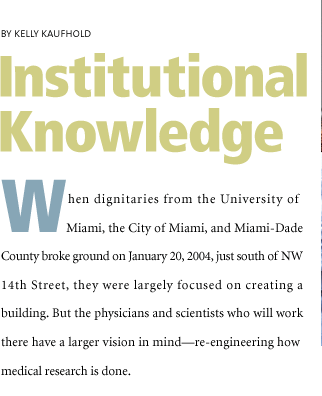 |
||
 |
 |
|
“The NIH Roadmap talks about clinical and translational research and lumps them together, emphasizing the need to translate from bench to bedside,” says Jay Skyler, M.D., professor of medicine, pediatrics and psychology, associate director of the Diabetes Research Institute, and director of the National Institutes of Health Type 1 Diabetes TrialNet.
The new mandate from the NIH is intended to speed medical research from the basic lab to patient care. That’s the mission of this new Clinical Research Institute.
“We want to narrow the divide between clinical trials and clinical care,” explains Richard J. Bookman, Ph.D., associate dean for research and graduate studies and director of the M.D. Ph.D. program. “This is an opportunity to transform how we do human subjects research on this campus.”
“We have the mandate from President Shalala and Dean Clarkson to build the best center of excellence for clinical research, in line with the NIH vision,” says Camillo Ricordi, M.D., senior associate dean for research and scientific director of the Diabetes Research Institute.
Ricordi asked Skyler to lead a committee of 29 faculty and staff members who face two difficult tasks. They’re inventing the concept of an institute for clinical trials to fulfill the promise of the NIH Roadmap.
And they’re deciding who moves in.
Committee members thought about who would use it—not just scientists, but research participants, clinical physicians, nurses, even representatives from the NIH and pharmaceutical companies. Skyler decided they should look at all these constituents with an eye toward customer service.
Like at The Ritz.
“We have a Ritz-Carlton goal in terms of service,” says Skyler. “This doesn’t mean we’ll have gold-plated water fixtures and trappings like that, but we need to be customer oriented.”
Patients—research subjects enrolled in clinical trials—will be seen on the same floor each time they visit. The complex also includes a new parking garage and a 60,000-square-foot employee wellness center.
Skyler got his hands on some business school case studies, and yes, The Ritz-Carlton hotel group was in there. But so were Jet Blue and Starbucks—companies that succeed by giving people what they want and doing it better than everyone else. If they do it well enough, then the company name becomes a brand.
That’s the idea behind the Clinical Re-search Institute at the University of Miami.
“We really want for a research participant to say to their friends, ‘You know, I was treated so well there that if you meet their research requirements you ought to be going there,’” says Skyler.
The new building is 15 stories tall with more than 350,000 square feet of research space, including shared resources like exam and procedure rooms, a blood lab, epidemiological and data services, radiology, a pharmacy, and conference rooms.

Sharing space lets more investigators in and ensures less idle time in virtually every room in the building. While plenty of people would like to work in a new facility, not everybody is willing to buy into a business school model with a mission statement and accountability.
“There has to be a certain leap of faith by the researchers to let us help make it work,” says James D. “Jay” Wilkinson, M.D., M.P.H., research associate professor of epidemiology and public health and senior epidemiologist, Division of Pediatric Clinical Research. “Most people have been receptive to it.”
 |
||
 |
“This is an opportunity to really look at how we do clinical research and update our strategic plan,” says Skyler. Last October the NIH announced plans for new Clinical and Translational Science Awards—the coin of the realm of the NIH Roadmap. To leverage that, the committee wants investigators who will bring their own funding and earn new grants, and who will take advantage of their neighboring scientists to do better, broader research.
And as investigators succeed—or fail—the institute will adjust.
“Interchangeability is built into these buildings,” says Ronald Bogue, assistant vice president for facilities. “For example, the electrical outlets are in the floor panels, so if you need to relocate where you need power you just move the panel.”
Because another tenet of the NIH Roadmap is to increase clinical research education, students and postdocs will also find a home here with a specific emphasis on training in clinical research. Most of the disciplines selected already know where they will work once the institute opens this spring. The Center for Research in Medical Education will be in there, as will a portion of Epidemiology and Public Health. Infectious disease investigators will work not far from colleagues working in oncology and behavioral health.
“The committee has taken this process very seriously,” Wilkinson says. “To us this is much more than a building.”